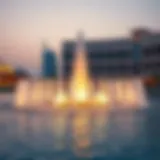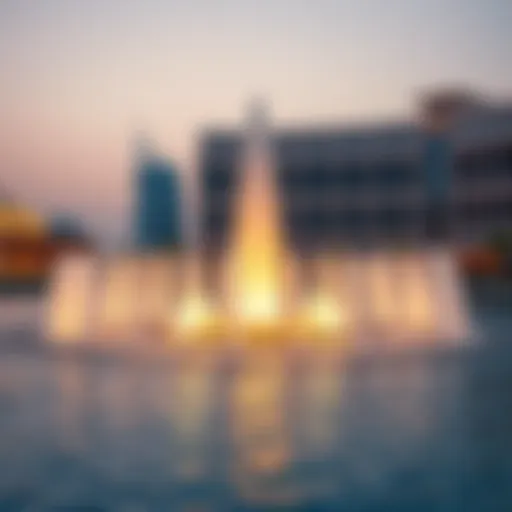Exploring حي ا�لشندغة: Dubai's Cultural Heritage
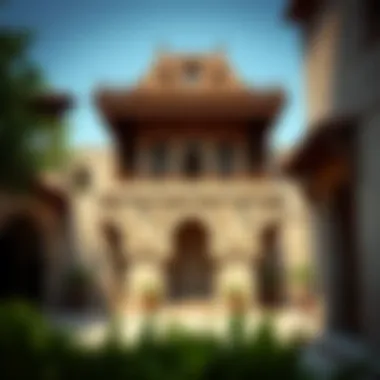

Intro
The historical district of حي الشندغة is not just a mere footprint of Dubai’s past; it encapsulates the essence of a city that has undergone tremendous transformation. The contrast between its humble beginnings and the bustling metropolis it is today speaks volumes about the dynamics of culture and commerce in this region. As we unravel the historical significance of حي الشندغة, we also explore how it has contributed to shaping modern Dubai, particularly in the realms of real estate and lifestyle.
This area, often overlooked in favor of modern skyscrapers, reveals stories of trade, architecture, and perseverance. Unraveling its layers provides insights not only into the past but also into the future of Dubai’s cultural landscape. The evolution of this neighborhood speaks to the heart of those interested in the intricate interplay between heritage and contemporary living.
In the following sections, we'll focus on market insights that emerge from this rich history, and how it influences current trends in real estate and lifestyle features in Dubai. Understanding this overlay of culture and commerce allows us to appreciate the significance of حي الشندغة not just as a relic of history but as a living dialog with the modern city.
Historical Context of حي الشندغة
Understanding the historical context of حي الشندغة is crucial for appreciating its role in shaping Dubai’s vibrant cultural landscape. This district not only reflects the city’s past but also highlights how historical influences meld into the modern fabric of contemporary life. As one delves deeper into its origins, trade significance, and architectural transformations, it becomes evident that حي الشندغة offers a unique lens through which to view the evolution of a city once defined by its humble beginnings as a fishing and trading settlement.
Origins and Establishment
The roots of حي الشندغة trace back to the 19th century when Dubai began to emerge as a significant port. The area was established primarily due to its strategic location along the coast of the Arabian Gulf, which attracted traders and merchants from neighboring regions. Early settlers recognized the potential benefits of trade in this burgeoning settlement, leading to the initial population growth that laid the groundwork for future developments.
The community that formed in حي الشندغة was characterized by its diverse population, with Arabs, Persians, and even Indians contributing to a melting pot of cultures. This mixture not only influenced the social structure but also fostered interactions that led to a rich tapestry of cultural traditions, as each group brought its own practices into the fold. The establishment of this neighborhood marked the beginning of Dubai's transformation from a humble town into a bustling trade hub.
The Role of Trade
Trade has always been a lifeblood for حي الشندغة. The district thrived because of its proximity to the Dubai Creek, which served as the primary maritime route for goods. This enabled effective import and export businesses, ranging from spices to textiles. The flourishing trade environment helped in establishing connections between distant lands.
One notable aspect was the emergence of the dhow trade. These traditional sailing vessels became symbolic of the region’s maritime culture, serving as the main carriers of commodities. As trading expanded, so did the socio-economic status of its inhabitants, enabling the district to evolve continuously. With each wave of economic activity, حي الشندغة became increasingly integral to Dubai, acting as a bridge between cultures and commerce.
Architectural Evolution
The architectural landscape of حي الشندغة is a testament to its historical significance. Over the decades, the area has witnessed a blend of traditional and contemporary design elements. The original structures, built using local materials such as coral stone, reflect the ingenuity required to adapt to the harsh desert climate. These early buildings were practical, featuring wind towers to cool interiors and large courtyards designed for social gatherings.
As Dubai embarked on its journey towards modernization, the architectural character of حي الشندغة started to alter. New constructions introduced modern amenities while also paying homage to their historical origins. It is fascinating to observe how existing structures have undergone restorations to preserve their heritage while harmonizing with new developments. This architectural evolution not only honors the past but also sets the stage for a dynamic future.
"The visual narrative of حي الشندغة illustrates the seamless coexistence of history and modernity in Dubai."
By examining the origins, the role of trade, and the architectural evolution of حي الشندغة, we gain a fuller understanding of its significance within the larger framework of Dubai's cultural identity. This historical context serves as a foundation for the following discussions about its cultural significance, offering insights that resonate with investors, homeowners, and expatriates alike, all of whom are interested in the intricate connections that define this remarkable district.
Cultural Significance
The cultural significance of حي الشندغة extends far beyond its geographical boundaries and into the very heart of Dubai's identity. This historical district represents a living testament to the city’s heritage, embodying the intricate tapestry of its past, present, and aspirations for the future. Its importance lies in multiple facets, including traditions, craftsmanship, and community initiatives that breathe life into its streets and buildings.
The vibrant culture of حي الشندغة acts as a bridge connecting the old with the new, inviting both residents and visitors to experience the unique character of this area. It showcases a remarkable blend of traditions that have been preserved over generations alongside an evolving urban landscape. For investors, homeowners, and expatriates, understanding this cultural backbone is essential as it influences the living experience, investment potential, and community cohesion in Dubai.
Traditions and Local Life
Within the narrow lanes of حي الشندغة, one can sense the strong pulse of local traditions that have shaped not just the district, but the entire city. Here, customs are not mere relics; they are alive and vibrant, manifesting themselves in everyday life. For example, the practice of communal meals during special occasions emphasizes the spirit of sharing, while the annual celebration of the UAE National Day invites families from all walks of life to come together in unity.
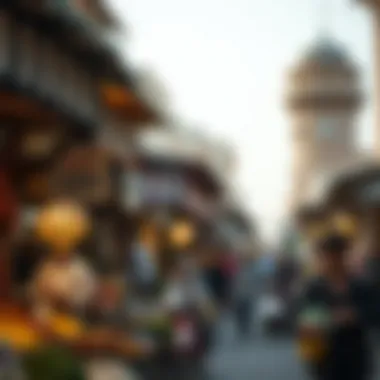

Traditionally, the district is characterized by a tight-knit community where everyone knows their neighbor. The local souq, or market, is more than just a place to buy goods; it is a social hub where people gather, exchange news, and engage in heartfelt conversations. This essence fosters a sense of belonging that residents cherish deeply, creating a warm atmosphere where hospitality reigns supreme.
Impact on Arts and Crafts
The artistic expression found in حي الشندغة tells stories that go beyond verbal communication. It lives within the handcrafted textiles, the ornate jewelry designs, and the intricate pottery that artisans skillfully create. The district not only encourages the preservation of traditional crafts but also serves as a platform for local artists to showcase their work.
Local galleries and exhibit spaces frequently host workshops and exhibitions that engage the community, allowing young artists to explore their creativity while connecting with their heritage. Consequently, this enriches the cultural fabric of Dubai, turning حي الشندغة into a vital incubator for artistic talent. The ways in which these crafts evolve also reflect broader societal changes, ensuring that tradition and modernity coexist harmoniously.
Community Gatherings and Festivals
Community gatherings in حي الشندغة are an essential component of its cultural significance. Seasonal festivals and events, like the Dubai Shopping Festival and Ramadan celebrations, draw crowds, both locals and tourists alike. These gatherings transform the neighborhood into a vibrant space of cultural exchange filled with music, dance, and captivating performances.
The Eid celebrations, in particular, are marked by decorations, traditional foods, and public festivities that allow participants to immerse themselves in the flavors and sounds of the UAE. Such events reinforce cultural ties and encourage social interaction, enriching the daily lives of both long-term residents and newcomers. The sense of community borne from these gatherings fosters a strong sense of pride in one’s heritage, making حي الشندغة a cornerstone of Dubai’s cultural landscape.
The vibrant culture of حي الشندغة acts as a bridge connecting the old with the new, inviting both residents and visitors to experience the unique character of this area.
By actively engaging with local traditions, promoting arts, and participating in communal festivities, individuals contribute to a living history essential to the identity of Dubai. In a world increasingly focused on the future, حي الشندغة stands as a reminder of the importance of understanding and preserving our cultural roots.
Architectural Highlights
The architectural landscape of حي الشندغة stands as a testament to Dubai's historical progression and cultural richness. This area is not merely a display of buildings but a rich tapestry that tells tales of its past — from its architectural styles to restoration efforts aimed at preserving its heritage. Understanding the architectural highlights provides insights into the identity and character of Dubai, shaping perceptions for investors, homeowners, and expatriates alike.
Characteristic Structures
One cannot delve into حي الشندغة without addressing its iconic structures, which reflect both the historical and cultural significance of the region. These buildings often showcase traditional Arabian design, characterized by wind towers, intricately carved wooden doors, and beautifully adorned interiors.
- Bastakiya Quarter: This area is famous for its narrow lanes and traditional courtyard houses, which have been preserved and restored, allowing visitors to glimpse life in the late 19th century. It's like stepping into a time capsule, presenting a stark contrast to the skyscrapers that dominate contemporary Dubai.
- Sheikh Mohammed Centre for Cultural Understanding: This center plays a pivotal role in educating visitors about local culture and traditions. The structure itself is a fusion of traditional design and modern architecture, emphasizing the blend of history and progress.
These characteristic structures not only attract tourists but also serve as functional spaces for community gatherings and events, reinforcing their importance within the social fabric of Dubai.
Restoration Efforts
The restoration of historic buildings in حي الشندغة is more than just a cosmetic upgrade; it’s about breathing new life into the stories these structures carry. In recent years, various initiatives have been launched to revive these architectural gems, focusing on authenticity and sustainable practices.
Restoration efforts often include:
- Utilizing traditional materials: Craftsmen often work with local materials to retain the original look and feel of the buildings. For instance, clay, gypsum, and palm fronds are used to maintain the age-old aesthetics.
- Community involvement: Local artisans and skilled workers are often recruited, ensuring that traditional craftsmanship is passed down through generations. This not only enhances the quality of restoration but also strengthens community ties.
Such efforts underscore a commitment to preserving history, acknowledging that without action, these buildings risk fading into oblivion.
Preservation of Heritage
Preserving heritage in حي الشندغة involves more than just safeguarding physical structures; it also encompasses the nuances of culture and community practices that accompany them. The preservation initiative draws on several strategies:
- Cultural Awareness Programs: Many educational initiatives are promoting understanding of local history and customs, aiming to instill appreciation among both residents and visitors. It's crucial to bridge the gap between past and present.
- Government Policies: The Dubai government has implemented strict guidelines to protect historical sites. The Directorate of Historic Buildings has made efforts to integrate these sites into the urban development plan while ensuring that the rich heritage is not compromised.
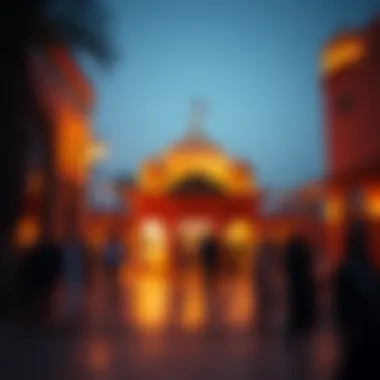

"The essence of حي الشندغة lies not just in the buildings, but in the stories and traditions that they hold."
The goal of preservation is to ensure that future generations can experience and learn from the rich tapestry of Dubai's history, promoting a cultural identity that resonates within the modern skyline.
Through these architectural highlights, حي الشندغة showcases a blend of historical significance and contemporary relevance, illustrating how a community can thrive while staying rooted in its heritage. This narrative captivates investors, homeowners, and expatriates, framing their understanding of the cultural landscape that shapes Dubai today.
Modern-Day حي الشندغة
In a rapidly transforming city like Dubai, حي الشندغة stands as an intriguing testament to how tradition can harmoniously coexist with modern development. Its significance in today's urban landscape isn't just a nostalgic nod to the past; it's a vibrant hub that plays a pivotal role in defining contemporary Dubai's cultural identity.
Integration with Urban Development
حي الشندغة has been at the forefront of urban planning in Dubai, where the old meets the new. The area has witnessed a wave of redevelopment projects that respect the historical architecture while accommodating modern facilities. Together, these elements foster a balance that appeals to residents and tourists alike.
As you stroll through the narrow lanes, there’s an evident juxtaposition of traditional wind-tower houses and sleek, modern amenities. It’s a visual treat, capturing the essence of Dubai's dual identity. Notably, the Dubai Creek waterfront has been revitalized, providing spaces for leisure and dining, without compromising the area's storied past.
- Newly built cafes along the creek offer stunning views, enticing visitors to soak in both the ambiance of the past and the pulse of the future.
- Art installations and public spaces have been introduced to foster community engagement, cleverly inviting residents to linger and partake in the area’s historical narrative.
Tourism and Economic Impact
Tourism is a lifeblood flowing through حي الشندغة's veins, fueling local businesses and invigorating the economy. This district attracts a diverse range of visitors—history enthusiasts, families looking for educational outings, and art lovers drawn by cultural festivals and exhibitions.
“The fine blend between old-world charm and modern-day allure makes حي الشندغة a captivating destination.”
The local economy has benefited immensely, seen in:
- Increased foot traffic to artisan shops and local markets, where travelers buy unique handicrafts and souvenirs.
- Economic models that allow traditional crafts to thrive alongside modern retail ventures, ensuring that the area retains its cultural essence.
As developments bridge the gap between the old and the new, the local economy keeps growing. Small businesses flourish, shaping a community that both respects its roots and embraces progress.
Living in حي الشندغة Today
Living in حي الشندغة today offers a unique experience that blends the vibrancy of modern urban life with rich cultural heritage. Here, one can wake up to the sounds of traditional music blending with the chatter of neighbors mingling at local cafes. The atmosphere is anything but ordinary.
Residents prize the sense of community that is often lost in larger metropolises. Monthly gatherings at the waterfront or occasional art fairs turn neighbors into friends, creating a tapestry of interactions that embody the spirit of this district.
There are multiple aspects that make living here appealing:
- Proximity to cultural centers and museums provides rich stimuli for daily life.
- Local governance encourages community involvement, promoting a shared responsibility for maintaining the area’s unique charm.
In this context, حي الشندغة evolves as not just a historical site, but as a dynamic, multi-layered community where history meets vibrant everyday life, serving as a prototype of how cities can grow while retaining their essence.
Real Estate Perspectives
Understanding the real estate dynamics within حي الشندغة is critical for various stakeholders including investors, homeowners, and real estate agents. The neighborhood's intricate relationship with Dubai's cultural and historical backdrop not only enhances its appeal but also informs current property market trends, investment opportunities, and the overall value of historical properties.
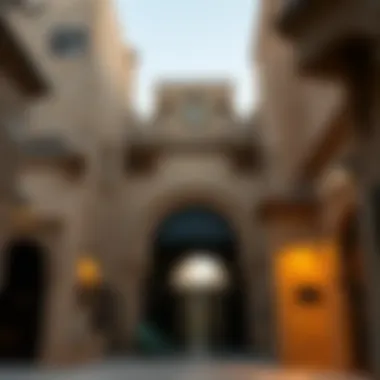

Property Market Trends
Recent data indicates that حي الشندغة has witnessed a pronounced shift in property market trends. Investors are increasingly drawn to the area's unique blend of historical charm and modern amenities. In comparison to other districts, prices in حي الشندغة are relatively balanced, making it appealing for those looking to dip their toes into the Dubai market without breaking the bank. Factors influencing these trends include:
- Cultural Resurgence: As the district becomes a focal point for cultural activities and tourism, property values are recognizing an upturn, as people prefer homes near vibrant community life.
- Urban Development Policies: Rules and initiatives aimed at preserving the area’s history while promoting new developments encourage a sustainable market that attracts varied demographics, from expatriates to local families.
- Increased Popularity: With notable investments in infrastructure and amenities, more buyers are considering حي الشندغة over newer developments, leading to rising demand.
Investment Opportunities
The investment landscape in حي الشندغة is diverse, offering numerous avenues for potential returns. For investors looking to capitalize on this historical district, consider the following benefits:
- Rental Yields: As tourism thrives, short-term rentals have gained traction, providing robust returns for investors renting properties to visitors seeking an authentic experience in Dubai.
- Cultural Grants and Incentives: The government promotes investments that enhance cultural heritage, offering financial incentives for property improvements and developments that align with these values.
- Rising Interest from Expats: Many expatriates are scouting for properties in the área for both residential and investment purposes, further driving demand and increasing property values.
Value of Historical Properties
Properties in حي الشندغة carry intrinsic value due to their historical significance and unique architecture. This value is compounded by several factors:
- Historical Preservation Efforts: As the district sees efforts to maintain its historical integrity, these properties are likely to increase in worth, especially appealing to investors focused on long-term gains.
- Community Identity: Ownership of a property with historical significance often nurtures a sense of pride and belonging within the community, adding intangible value beyond the monetary aspects.
- Cultural Tourism: Historical homes attract tourism, creating opportunities for commercial ventures—including boutique hotels or cultural experiences—that further enhance their market value.
"Investing in حي الشندغة is not just about the property itself; it’s about becoming part of a living history, enriching both personal and financial returns."
By considering these perspectives, stakeholders can better understand how to navigate the complexities of the حي الشندغة real estate market, ensuring they are well-equipped to make informed decisions. Whether you are a homeowner looking to settle down or an investor eyeing lucrative opportunities, the merging of history with modernity in this district presents a unique landscape for all.
Challenges and Future Outlook
The Challenges and Future Outlook section is crucial for understanding the path ahead for حي الشندغة. This historical neighborhood, rich in both culture and heritage, faces a multitude of obstacles in today’s rapidly evolving urban landscape. As Dubai continues to expand at a breakneck speed, balancing the quest for modernity with the need to safeguard historical identity becomes a pressing issue. Recognizing these challenges offers investors, homeowners, and expatriates invaluable insights into the intricacies of preserving a community that is steeped in history yet striving toward a modern future.
Balancing Development and Preservation
Finding the right equilibrium between development and preservation is no small feat. As new projects loom on the horizon, the risk of overshadowing the cultural essence of حي الشندغة is palpable. For instance, towering skyscrapers sprouting close to traditional structures can create a stark juxtaposition that might alienate both locals and tourists alike. The task at hand is multifaceted:
- Regulatory Framework: Establishing zoning laws that respect historical boundaries while still allowing for urban growth.
- Community Input: Engaging with local residents to garner support and ideas that reflect their vision for the future of their neighborhood.
- Architectural Integration: Adopting a design philosophy that harmonizes modern infrastructure with historical design elements can yield aesthetically pleasing results.
In recent years, initiatives have emerged to redefine what development looks like in حي الشندغة. The Dubai Culture and Arts Authority, for example, has been working tirelessly to promote sustainable practices that respect historical contexts. A concerted effort to preserve such landmarks allows the area’s character to thrive amid modernization.
Community Engagement
Another pillar of resilience is community engagement. Involving local stakeholders in the decision-making processes can lead to richer, more genuine developmental outcomes. Community engagement isn’t only a lofty ideal; it’s a means to ensure that dwellers feel a sense of ownership over حي الشندغة. Successful tactics include:
- Workshops and Forums: Conducting regular meetings where residents can voice their concerns and aspirations helps build trust and transparency between developers and the community.
- Cultural Events: Initiatives like art festivals or heritage fairs can celebrate local traditions, fostering a deeper connection to the area’s history while encouraging tourism.
- Educational Programs: Trials to educate the youth through school programs centered around local heritage can help the younger generation appreciate their rich history, aiding in overall preservation.
"True community engagement transforms a neighborhood into a living entity where history and future coexist harmoniously."
Vision for the Future
Looking ahead, the vision for حي الشندغة must include a blend of innovation and respect for the past. As investors and real estate developers turn their eyes toward this historic district, the demand for thoughtful strategies that consider both commercial opportunities and cultural integrity will be paramount. Key considerations include:
- Sustainable Development: Prioritizing green spaces and energy-efficient buildings can enhance livability while ensuring that future generation have enjoyable spaces.
- Innovative Design Solutions: Incorporating technology in preserving historical sites presents opportunities to create interactive experiences that engage visitors while safeguarding heritage.
- Collaboration with Experts: Partnering with historians, architects, and urban planners specialized in heritage conservation can foster unique and sustainable developments.
By visualizing a future that is not just about profit margins but also cherishing the past, the community of حي الشندغة can evolve without losing its identity. Reinventing the area while celebrating its roots assures all those involved—homeowners, investors, and visitors alike—that the rich cultural tapestry of Dubai remains intact in a dynamic world.
For further insights on heritage preservation, you may check resources at Wikipedia and Britannica.












